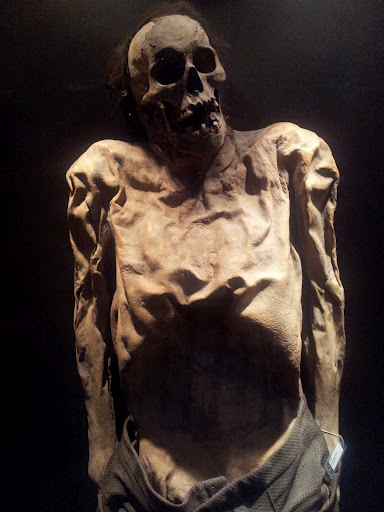In our travels this year we’ve been to three museums with mummies. In Istanbul, there is a classic Egyptian mummy, King Tabnit, on display. He’s displayed next to Alexander the Great’s sarcophagus. In Arequipa, Peru, we saw a frozen mummy named Juanita, who was sacrificed on top of a 6300 meter mountain, Mt Ampato. She was basically freeze-dried and is now displayed in a glass-walled freezer. In Guanajuato, Mexico, we visited the Museo de las Momias. Here instead of one mummy, there are scores of mummies, literally halls of dead bodies, mummified not by intent but by a natural phenomenon.
Warning: Below is a picture of one of the mummies. If you’re squeamish, don’t continue.
I’ve read of two theories of how the mummies came to be. In the first theory , some of the bodies of the dead were placed in crypts above ground since the 1700’s. The worms couldn’t get into the crypts to crawl in and crawl out, and there was no moisture in the air. So the bodies just dried out, completely. On the other hand some of the locals say that the soil is of a special composition of minerals and that some those bodies which were buried were mummified through a chemical reaction with those minerals. The mummies were first discovered when in the mid-1800’s a tax was placed on families for the upkeep of the cemetery. If the family couldn’t afford the tax, or if there was no family, the body was exhumed. To the surprise of the officials they exhumed mummies.
Most of the mummies are in amazing condition with their dry, papery skin still intact. Many are wearing their shoes and socks. Some still have on some article of clothing. One man is wearing a pair of polyester pants which look as good as new. Most are, however, naked, many fully intact though shrunken. There are people from all walks of life. The first mummy exhumed was a foreign doctor. One mummy has a huge wound over his liver where he was stabbed. Another mummy has her arms over her face as if she struggled within her tomb. It is believed she was buried alive while in a state of catalepsy. Babies are buried in their christening gowns. A mother was buried holding her premature infant. A tiny embryo was discovered mummified within a crypt, the mother’s body having disintegrated around it. For a really ghoulish display, a side museum keeps the mummified body of a “vampire”, a body with two very long pointed canine teeth in its mouth and a wooden stake through its heart.
Somehow it fits that these mummies were discovered and are displayed in Mexico. This is the land of the Aztec. The people who sacrificed their own by pulling out the still beating heart of their victims. Artifacts from the days of the Aztecs and other more ancient peoples often have images of death or murder painted or sculpted on the side. Small clay skulls line the edge of a vessel kept in a museum here in Guanajuato. It was the Aztec rituals which became the current celebration of the Dia de los Muertos. Throughout Guanajuato we’ve found sculptures of skeletons performing every day tasks: the doctor skeleton, the bride skeleton, the mariachi skeleton. Paper mâché skulls painted in bright colors are decked with butterflies. The symbols of death are beautified and even glorified. Here it’s not so creepy to display these mummies. It fits in with so much else we’ve seen here. Maybe unlike the US, death is accepted here. After all, it is part of everyone’s life. We got to see it at the Museo de las Momias.
The picture above is gross. Sorry to those for whom it was too disturbing. But if you’re one of the ones who’d like to see more go here.

